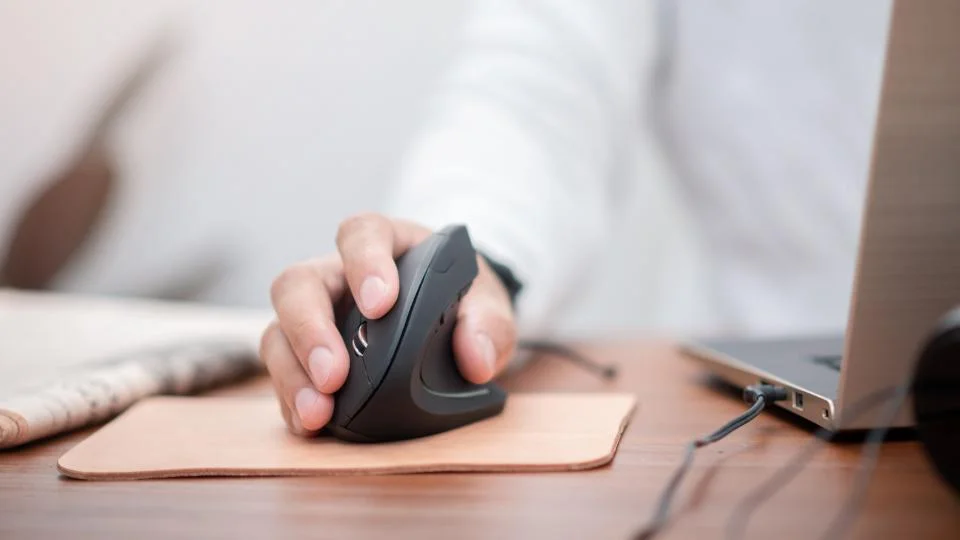
My practice is located in downtown Nashville, Tennessee. The majority of my patients come from the surrounding office buildings and high rises.
90% of those patients sit at workstations. My practice was built on successfully treating repetitive injuries from poor workstation ergonomics and poor sitting posture.
I quickly saw the importance of preventing the overuse issues by offering a workstation checklist to give to each of my new patients.
I certainly enjoy writing articles such as this one, however, it can be challenging to have proper ergonomics at home with my laptop. It's easy to fall into bad habits of sitting on the couch at my dining room table.
In this article, I will share with you how to set up a healthy workstation at home or at the office and prevent the damaging effects of prolonged sitting in 12 easy steps.

Dr. Angela Walk
Sports Chiropractic Physician
Founder of Nashville Organix
Tip #1. Use a comfortable chair that supports your spine

The most supportive office chairs enable you to adjust the height, the height of the arm rests, seat depth, and the angle of the reclining feature. It's important to have a highly adjustable chair that will fit a variety of body types and sizes,
Make sure all of these adjustments are correct for you.
The chair height should allow your feet to be flat on the floor with knees and hips level with the floor
The arms rest height should allow for your shoulders to relax and drop comfortably
Your elbows should be bent at a 90 degree angle

Your back should be pressed firmly against the back of the chair. The best office chairs support the "S" shape of your spine. If your chair does not have this type of support, a lumbar support cushion is recommended.
A lumbar support pillow will encourage you to sit properly with a more upright posture.
Tip #2. Maintain Proper Sitting Posture

It's difficult to maintain proper posture while we are sitting and most of us spend more time "slumping" and leaning forward that we do sitting upright.
For every inch the head juts forward, you are placing an additional 10 lbs. of stress on the joints of the spine and muscles.
During posture evaluations, chiropractors regularly observe many of their patients carrying their head two to three inches forward, which is an extra 20-30 pounds of pressure on their neck.
Proper posture is lining the center of the ear up with the center of the shoulder. Try improving your sitting posture by placing your lower back firmly against the back of the chair and using a lumbar support, and holding your head upright, chin level, and chest high.
Tip #3. Set your monitor at the proper height
Place your monitor so your eye level is about 2 to 3 inches below the top of the screen and about an arm’s length away.
The monitor should always be directly in front of you at a distance of 20-40 inches from your face.
Adjust the brightness and contrast of your monitor so that you can see clearly and without unnecessary strain. Avoid shifting your head forward or bending your neck to see the screen more clearly.
If you use a laptop at your workstation, consider using a docking station to raise your laptop screen to eye level or plug your laptop into a real monitor, keyboard, and mouse.
Tip #4. Keep your keyboard at the right height.
Ideally, when you’re typing on a keyboard, your arms and wrists would be in a neutral position: parallel to the floor or angled down toward your lap to reduce strain.
Avoid bending your wrist sharply upwards or downwards to type. Since most desks are fixed height, it is best to adjust the chair height for the correct position of the arms and hands.
Choose an ergonomic keyboard with a split keyboard that helps you keep your mouse close to your keyboard. It's helpful to cushioning for your wrist and palm as well.
Tip #5. Use a mouse that fits your hand

A responsive mouse that is comfortable to use will help to reduce strain on your hands. Place the mouse near the keyboard. Keep it in a position that will enable you to transition between typing and using the mouse with as little effect on your arm and wrist posture as possible.
Using repetitive motions on your mouse can stress muscles in your fingers and wrists in the same way that repetitive typing can cause fatigue or pain. At the minimum, most people should look for a mouse that is comfortable to grip and smooth to maneuver.
An ergonomic mouse can lessen the strain on your hands and fingers.
Tip #6. Have good lighting
Ergonomics experts recommend good lighting to reduce eye strain and avoid shifting your head and neck forward at an unnatural angle. An abundance of natural lighting in your workspace is ideal.
If you don’t have windows in your home office, or when you’re working late or on cloudy days, add lamps or additional overhead lighting with a task lamp to balance the light and help you focus.
Tip #7. Change your posture regularly
Regardless of how healthy your work posture is, sitting in any one position for an extended period is not healthy. It is best to alternate your position frequently.
I recommend standing every 20-30 minutes. I know that may seem impossible, and you may be thinking "How will I get anything done?".
Research indicates that it is PROLONGED STILLNESS that creates more consequences from sitting. Frequently changing positions is the proven remedy for a healthy workstation.
Even if you do not leave your work area, stand, stretch, squat, take steps in place for 20-30 seconds or set a timer on your phone or fit bit to remind you to stand!
In recent years, research has shown that the more time you spend sitting, the shorter and less healthy your life will be. Studies have also shown that those who sit more are more likely to have chronic pain, diabetes, heart disease, and higher cholesterol.
Researchers at Northwestern University found each additional hour spent sitting increased risk of physical disability by nearly half.
What’s even more concerning is that studies show that even if you exercise, it's not enough to counteract the negative effects of prolonged sitting.
Tip #8. Reduce stress while you’re working
Any type of stress or anxiety can cause your muscular tension. So include things in your workspace that will help you relax.
Try chair yoga ~ stretch while seated to reduce muscular tightness
Practice deep breathing
Listen to your favorite music
Diffuse essential oils to create a calming atmosphere and make you feel relaxed or more alert.
Tip #9. Get a phone headset.
If you spend a lot of time on the phone, a hands-free set will leave your hands for other tasks. It will also prevent awkward neck positions from perching a phone between your shoulder and your ear.
Tip #10. Get An Adjustable Workstation

Creating a healthier workstation with standing desks is becoming increasingly popular and for good reason. I recommend an adjustable workstation versus a stand only workstation.
Standing for 6-8 hours a day comes with it's own set of disadvantages. Standing for prolonged periods puts too much stress on our joints and you're still inactive.
Adjustable workstations allow you to alter your position from sitting to standing. I recommend standing for 1 hour to 90 minutes, then sitting for 1 hour to 90 minutes.
Constantly changing positions and avoiding staying in one position for too long seems to be the best remedy to counteract the negative effects of sitting. Wearing supportive footwear and standing on a fatigue mat is also helpful while you are standing.
Tip #11. Perform core exercises

Sitting weakens our posterior chain core muscles (lower back, gluts, hamstrings, and postural muscles). Each time you stand throughout the day, perform a strengthening core exercise.
Prolonged sitting also leads to repetitive strains and poor movement patterns. Poor movement patterns lead to low back pain, hip pain, headaches, migraines, neck pain, and shoulder pain.
Sitting puts more stress on the joints of the spine, discs, and muscles than any other position. We weren't meant to sit as much as we do. The core strengthening protocol that I use in my office is Foundation Training.
It is a series of exercises designed to change destructive movement patterns and build a powerful posterior chain which begins with a strong low back.
Foundation Training is based on simple, but unique idea that strengthening the upper back, lower back, gluts, hamstrings, and inner thighs allows the strong muscles in the back to do their job of supporting the weight of the upper body and maintaining upright posture.
Take a look at one of my latest blog posts the 3 Best Exercises for Back Pain that feature Foundation Training.
Tip # 12. Drink more water throughout the day
We know that drinking adequate amounts of water is an important part of maintaining good health, but it also ensures that we leave our workstations more often as it increases restroom visits.
Dehydration can cause many health concerns including muscle and joint pain, fatigue, headaches, constipation, and even weight gain. It is recommended that we drink half of our body weight in ounces of water.
If you weigh 150 lbs., you need 75 ounces of water per day. And if you exercise, you need more. Always drink pure, filtered water as it is free of potential contaminants found in tap water.
A good way to see if you are getting enough water is to look at the color of your urine. In most cases you want to drink enough water to turn your urine a pale yellow.
Frequency of urination can also be used to judge your intake. If you haven't urinated in several hours, you could be dehydrated.
Summary
Creating the perfect workstation environment can be a challenge, but practicing these tips more throughout the day will prevent many workstation injuries from occurring.
Prolonged, static postures will eventually create mechanical issues and take a toll on your body, so take intermittent breaks and avoid sitting in one awkward posture for too long.
Healthy Workstation Recap:
Adjust your chair, monitor, and keyboard to the appropriate height and position
Take frequent breaks every 20 to 30 minutes.
Always try to get away from your computer during lunch breaks
Avoid eye fatigue by resting and refocusing your eyes periodically. Look away from the monitor, and focus on something in the distance.
Use correct, upright posture with your head and ears in line with your shoulders

Hi, I'm Dr. Angela Walk I have been involved in the health and wellness industry for over 25 years as a natural physician and sports chiropractor specializing in foot and gait analysis.
I have written extensively for health publications and I am keenly aware of trends and new developments in natural health. I embrace an active lifestyle combining diet, exercise and healthy choices. My goal is to inform my readers of natural options available to them in hopes of improving their health and quality of life. GET FREE ACCESS! Dr. Angela Walk is on a mission to provide you and your family with the highest quality natural tips and organic products...Join me on my Facebook Page or Instagram Page.
_edited.jpg)